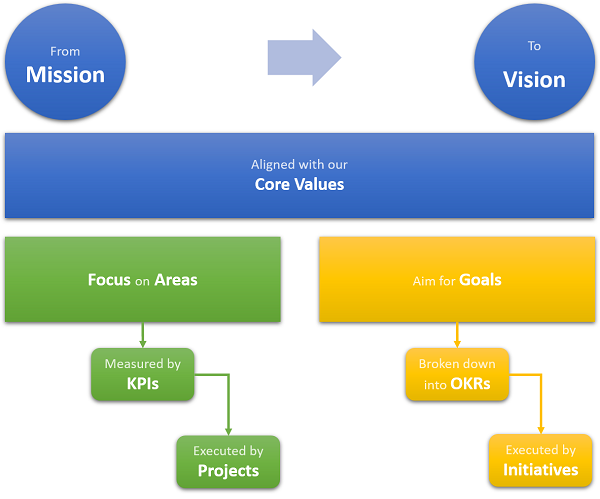OKRs and Strategy
Stop confusing OKRs and strategy! It is true that the two are closely related. But one does not replace the other. Rather, they complement each other.
Intro
What is strategy?
In the broad sense, strategy refers to the way in which a collective establishes its fundamental orientations. Moreover, this also includes changes of course if necessary.
Strategy is the best estimate of where the organization should focus for the next time horizon. It is the job of the board to strategize and steer their teams towards this desired intention.
The strategy is both external, with the market strategy; and internal with organizational and group strategy (vertical integration, partnership, diversification, etc.), and the business units’ strategies (positioning, competitive advantages, etc.).
More precisely, the strategy of the business units is to maximize performance in a given field of activity and to create competitive advantages.
OKRs and Strategy
OKRs are part of the execution of strategy. Team OKRs (or tactical OKRs) serve company strategy. They don’t determine it. Any OKR that does not clearly contribute to the company’s strategy should at least be questioned.
We therefore understand that OKRs do not replace strategy. And for an OKR program to be successful, there needs to have a clear strategy.
Deliberate and emergent strategy
However, we can moderate this statement. Indeed, the strategy consists of two parts: the deliberate strategy and the emergent strategy.
Part of the strategy more or less emerges from the actions of the company. Actions converge over time into modes of action. It is a strategy that appears without clear intentions.
Emergent strategy encourages learning, unlike deliberate strategy based on execution.
Both strategies are necessary in an organization. Not to accept it would be to fail to recognize that an organization is a complex system. But we must create the conditions for this emergence to be positive.
As a result, using OKRs without a strategy is part of the emerging strategy. This is the case, for example, with OKRs built from the company’s roadmap! It can also be a consensus strategy if it is the result of a lot of independent decisions made.
OKRs, an iterative strategy validation tactic
Team OKRs can challenge all or part of the strategy along the cycle. Remember that the strategy is only an assumption developed by the board. It may be invalidated by the facts!
To truly harness the power of OKRs and strengthen organizational agility, leaders need to be open to evidence that contradicts company strategy. The data-driven approach to key results facilitates this awareness. We’re talking about facts, not opinions.
The sooner the company can find out that it is working on the wrong direction, the sooner it can pivot to a better hypothesis.
OKRs make it possible to focus on the results to validate the strategy in an iterative manner.
Another reason to put this method in the more general framework of agility! Which we can compare to incremental approaches such as Beyond Budgeting.
What’s next?
A strategy template
No more excuses for confusing OKRs and strategy! On the other hand, the bad news is that we need to strengthen our game in the area of strategy to improve our goals …
For that, we offer you a template to organize your strategy in our next article.






Recent Comments